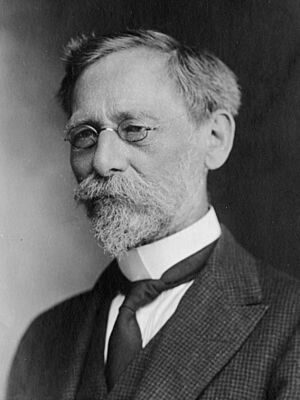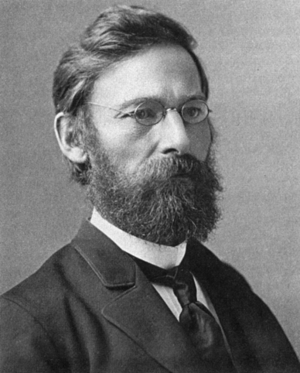Leonhard Stejneger facts for kids
Quick facts for kids
Leonhard Hess Stejneger
|
|
|---|---|

Stejneger, c. 1910s
|
|
| Born | October 30, 1851 |
| Died | February 28, 1943 (aged 91) |
| Education | Ph.D., University of Christiania |
| Occupation | biologist |
Leonhard Hess Stejneger (born October 30, 1851 – died February 28, 1943) was a famous scientist who studied animals. He was born in Norway but later became an American citizen. He was an ornithologist (someone who studies birds), a herpetologist (someone who studies reptiles and amphibians), and a zoologist (a general animal scientist). Stejneger was especially known for his work with reptiles and amphibians.
Early Life and Education
Leonhard Stejneger was born in Bergen, Norway. His father, Peter Stamer Steineger, was a businessman. His mother was Ingeborg Catharine Hess. Leonhard was the oldest of seven children. His sister, Agnes Steineger, became a well-known artist in Norway. His family was wealthy until 1880, when his father's business faced problems and he lost a lot of money.
Leonhard went to the Smith Theological School in Bergen from 1859 to 1860. He then attended Bergen Latin School until 1869. He became interested in animals very early in his life. By the time he was sixteen, he had already made a list of birds he had seen. He also enjoyed painting birds using watercolors.
Around 1870, he changed the spelling of his last name to "Stejneger," which he used for the rest of his life. He studied law and philosophy at the University of Christiania (now the University of Oslo). He earned a Ph.D. degree and worked briefly as a lawyer.
A Career Studying Animals
In 1880, Stejneger got a special walking stick that had a small gun built inside it. He used this tool to collect animal specimens for his studies throughout his life. In 1881, Stejneger moved to the United States. He had married Anna Norman in 1876, but she did not move with him, and they later divorced.
When he arrived in the U.S., he went straight to the Smithsonian Institution in Washington, D.C. This is a famous museum and research center. He met Spencer Fullerton Baird, who was a well-known scientist there. Baird knew Stejneger was very skilled, and Stejneger started working at the Smithsonian soon after. He became an American citizen in 1887.
Stejneger went on many trips to explore the northern parts of North America. From 1882 to 1883, he explored Bering Island and the Kamchatka Peninsula in Russia. In 1895, he visited the Commander Islands to study fur seals for the U.S. Fish Commission. He went back to the Commander Islands again in 1922.
At the Smithsonian Institution, Stejneger advanced in his career. In 1884, he became an Assistant Curator for birds. A curator is someone who manages a collection of objects, like animal specimens. In 1889, he became the Curator for reptiles. In 1899, he became the Curator for both reptiles and amphibians. From 1911 until his death, he was the Head Curator for biology. He was even allowed to keep working past the usual retirement age by a special order from the president!
Stejneger wrote more than 400 scientific papers. These papers were about birds, reptiles, seals, and the herpetology (study of reptiles and amphibians) of Puerto Rico, among other topics.
During his trip to Bering Island, he became very interested in the life of Georg Wilhelm Steller. Steller was a naturalist from the 1700s who had also visited the island. Stejneger spent many years researching Steller's life. This research led to his only non-scientific book, a detailed biography of Steller, published in 1936.
Stejneger was a lifelong member of the Bergen Museum in Norway. He attended many important science meetings around the world, including several International Congresses of Zoology. He was recognized for his work in many ways. In 1900, he won a gold medal at the Paris Exposition for his work on managing and protecting fur seals. In 1923, he was chosen to be a member of the United States National Academy of Sciences, a very high honor for scientists. In 1931, he was made honorary president for life of the American Society of Ichthyologists and Herpetologists. He also received honors from Norway, becoming a knight and then a Commander of the Royal Norwegian Order of St. Olaf.
Legacy and Discoveries
Leonhard Stejneger is remembered in the scientific names of many animals. This means that other scientists named these animals after him to honor his contributions.
Here are some of the reptiles named after him:
- Amphisbaena stejnegeri
- Aspidoscelis tigris stejnegeri
- Crotalus stejnegeri
- Gloydius intermedius stejnegeri
- Hemidactylus stejnegeri
- Pseudoxenodon stejnegeri
- Rhinotyphlops stejnegeri
- Sceloporus stejnegeri
- Sphaerodactylus cinereus stejnegeri
- Takydromus stejnegeri
- Trachemys stejnegeri
- Trimeresurus stejnegeri
- Uta stansburiana stejnegeri
He is also remembered in the names of some bird species, such as:
- Mellanitta stejnegeri
- Saxicola stejnegeri


